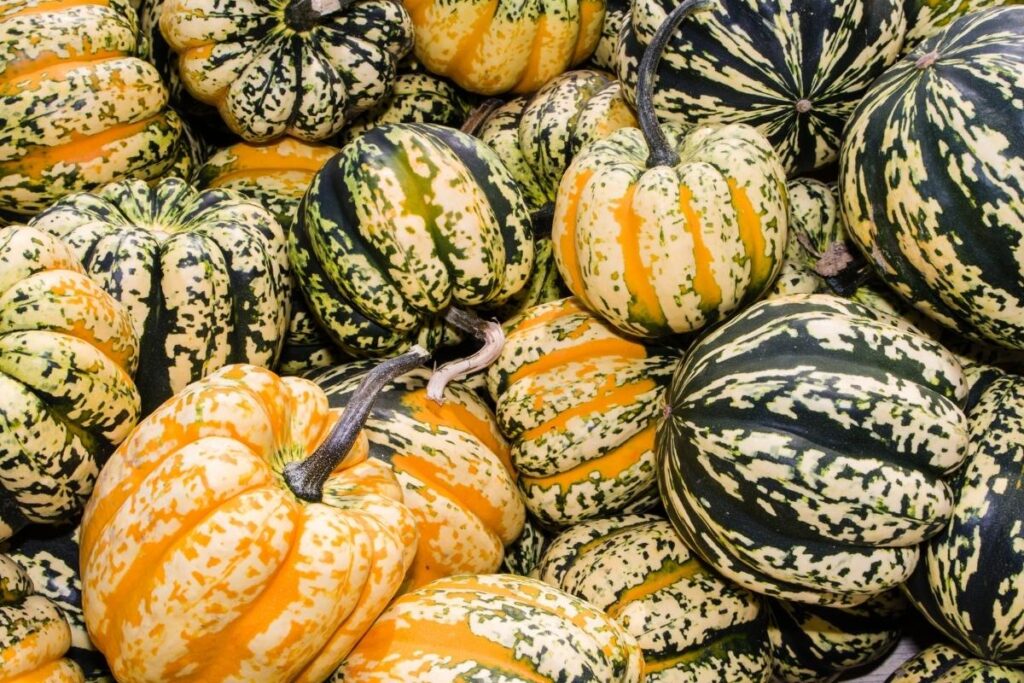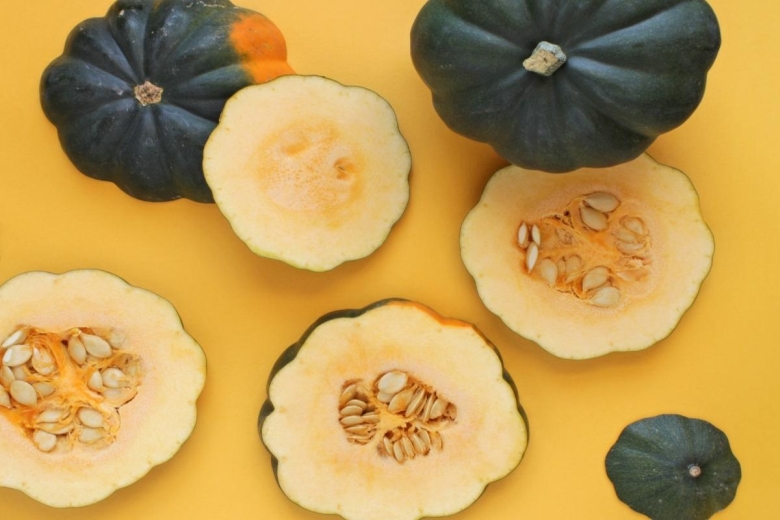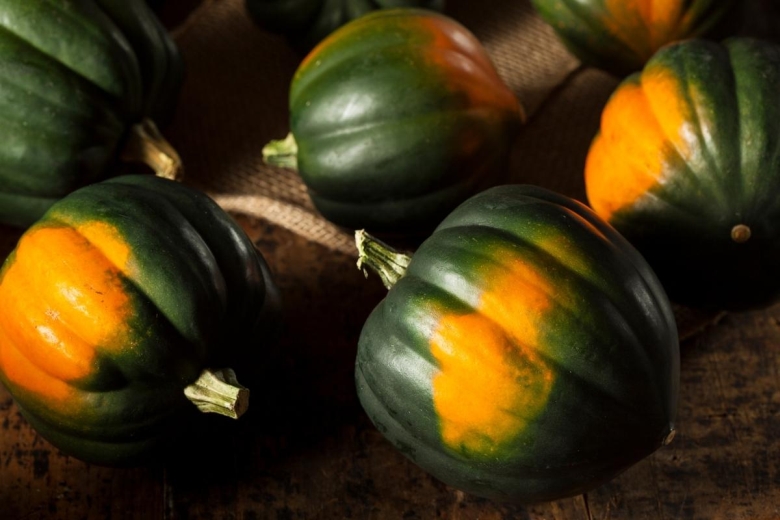
As the temperatures dip and the leaves are falling, everyone knows that’s when it’s time for Monday night football, hot cocoa, crackling fires, and when to pick acorn squash! Acorn squash is a fairly carefree addition to your garden and can provide a harvest that, with the proper care, can grace your supper table throughout the entire year.
While it’s labeled as a “winter squash,” the acorn squash is not grown in the winter. The term “winter squash” derives from the strain’s ability to withstand long storage over the winter, unlike other varieties of winter squash, such as butternut and spaghetti. With its tough outer skin the acorn squash stays fresher longer than its brethren.
That being said, don’t worry about getting bored with its mild flavor, though. It features equally well in both sweet and savory recipes. Whether you prefer to satiate your sweet tooth by serving it with a bit of nutmeg, butter, and brown sugar, or prefer to stuff it with hearty meats and herbs, when it’s harvested, acorn squash is ready to take the culinary spotlight—whether as the main event, a delightful side dish, or a delicious dessert. But when is the best time to pick acorn squash?
“Picking” the Perfect Time
Have you ever thumped on a melon in the produce aisle of your local grocery store? Many of us have acquired unique ways of determining the best fruit and vegetables when fulfilling our weekly shopping lists. But there are ways you can exercise some harvest savvy in your garden as well.
First, of course, you’ll want to note the average harvest time for the particular variety of acorn squash you are growing. Most variants will ripen in about fifty to sixty days after you first spy it on the vine. In all, this ranges from eighty to a hundred days after planting, give or take. If you are cultivating your squash from commercial seeds, you can narrow the time frame more specifically with information provided by the seed company. However, nothing beats the five senses to clue a gardener in on the best time to harvest their squash.
What a Ripe Acorn Squash Looks Like
Bigger is not always better. Don’t be misguided by an acorn squash that appears fully-grown. As a variety, acorn squash typically grows quickly. Though it may appear to be a mature size, it’s often not reached its peak perfection yet. What you want to look for is other subtle changes in the squash to indicate its readiness for picking.
As an acorn squash matures, you can observe its deep green rind mottled by a patch of yellow. Keep a weather eye on this spot. When it deepens to a warm orange, it’s likely time to harvest. Don’t wait too long, however! If your squash sports more orange than a Longhorns football game, you’ve fumbled, and you’re left with a squash that is overripe. Do take note that there are a few varieties that do present fully orange at time of harvest. With any variety, you’re looking for a stem and vine that has faded from bright green to a dull brown.
Another tell-tale feature of a ripe acorn squash is whether its skin is shiny or dull. If a squash’s skin is a deep, dull green, it is likely ripe and ready for picking. A shiny skin is usually seen on an immature squash. This indication doesn’t always work in your grocery store produce section, however, as some farmer’s will add a superficial coat of wax to the produce they supply.

What a Ripe Acorn Squash Feels Like
Have you ever heard the expression “tough as nails”? Acorn squash is a hearty vegetable with a tough skin. When that skin is at its toughest, your squash is ready to be picked. This is when feeling your squash can help you determine just whether it is fully ripened. Gently push the tip of your fingernail against the skin. If you are unable to break the outer rind, start picking! If, on the other hand, your nail easily breaks the green surface skin, give that squash more time to ripen on the vine.
As tough as its skin might be, a ripe acorn squash will also offer a little bit of give when you press against it and spring right back. Don’t confuse this with a soft spot! A squash that gives under pressure and does not spring back is likely overripe. Conversely, if you find a squash with absolutely no give and is rock hard, it isn’t quite ready for its closeup. Give it some more time on the vine.
How the Inside of a Ripe Acorn Squash Looks and Tastes
If you’ve picked a squash from the vine and still are a little unsure of its ripeness, look at the color of the flesh inside. A fully ripened squash boasts a rich, golden flesh. The flesh of an immature squash is likely to be a pale yellow. It may even have bits of green flecked throughout. Take note—unlike some winter squash, acorn squash will not ripen once plucked from the vine.
If you’ve picked too soon, however, don’t fret. Immature acorn squash can be eaten. It will just present with a different taste profile on the palate. Immature acorn squash will have a taste which is more akin to a summer squash variety, such as zucchini. It can even be flavorless or even bitter, though there are some environmental factors such as extreme temperature fluctuations or subpar irrigation that can increase the cucurbitacins, the biochemical compound responsible for bitterness and function primarily as a deterrent against herbivores who might otherwise feed on the growing squash.
A mature acorn squash which has seen a consistent growing season develops a sweeter, nuttier taste.
Be advised—even with their tough skins, acorn squash are sensitive to frost. Be certain to pull them off the vine before the first hard frost comes, or you’ll lose the crop. Frost damaged squash will develop undesirable soft spots and will not keep. Discard it as you would overripe or rotten squash.
If you strongly feel they just need a little more time on the vine and the weather is chilly but not bitterly cold, be sure to protect them with a secure tarp. Most growers will pick the best harvest in late September into October.
How To Pick Acorn Squash
A ripe acorn squash should easily snap off the vine, but it is recommended to employ a sharp tool when harvesting. Using an implement like clippers or pruning shears will ensure the squash’s stem remains intact, helping the squash retain moisture and not damaging the remaining plant so it may continue to bear fruit.
It is not advisable to use force to pull the squash from the vine as this can do damage to squash which are still growing and ripe enough for picking. Some varieties of squash can be harvested using a twisting method to free it from the vine, but again, this can potentially do damage to the plant’s stem and is not recommended.
So, what’s the Goldilocks length for cutting your acorn squash stem? When your acorn squash is ripe, measure approximately one to five inches of stem atop your squash to make the cut. Use a sharp tool for a clean, precise cut. This benefits both the squash and the plant, making sure your squash won’t show signs of premature decay and keeps the plant healthy to continue producing.

Curing and Storing Acorn Squash
You’ve reaped the benefits of your lovely winter squash crop—but don’t go farm to table just yet! Take some time to cull through your squash and ferret out any damaged specimens. If you come across a squash presenting soft spots or scars in the skin, it is highly recommended those be eaten promptly. Squash with these conditions will not cure and store well and can even affect the remainder of your harvest if not stored properly.
Speaking of storage, in order to bring the tastiest vegetables to your table, acorn squash must undergo a curing process like many other varieties of winter squashes. The best curing techniques include an ample, dry space, cool temperatures, and rotation. Once you’ve located a dry space to cure your squash, make sure the temperature hovers around fifty to fifty-five degrees.
Variances in either direction invited damage to your harvest. Then, give your squash some breathing room. Don’t allow them to touch, a practice which would encourage the rapid development of soft spots and rot. Give each squash a spin, rotating them a quarter of a turn daily to provide equitable airflow for the rind to harden and the stem to fully dry.
After the curing process is complete, you can keep your acorn squash for up to two months in a cool, dry place, standing independently of one another. If you’d like to enjoy the fruits of your labor well into the next year, you can store cooked acorn squash for up to twelve months.
To cook your squash, remove the ends. Take out the seeds and the fibers in the middle. Once the flesh is removed from the green skin, cube it. Once it’s cubed, you have a variety of cooking methods available to you—baking, boiling, steaming—to soften the cubes. When the squash has softened, you can either arrange the cubes on a cookie sheet and freeze or mash the softened flesh. Either way, store the frozen squash in an airtight container or freezer bag to be on hand whenever your taste buds come calling. Once you’ve reheated the squash, it will keep for approximately four days in the refrigerator.
FAQS
How can you tell if your acorn squash is ready to harvest?
If the skin of your acorn squash is a dull green and resists puncture from your fingernail, it is likely ready for harvest. Be sure to check the yellow spot where you squash has been resting on the ground. When the yellow has deepened to a warm orange, this is another indication your squash is ready to be picked. Other indicators the squash is ripe can be seen in the stem and vine which wither to a dry brown when the squash is ripe.
Does acorn squash ripen once it’s picked?
Once an acorn squash is harvested, it will not ripen like some other winter squashes. This is why it is important to ensure your squash spend enough time on the vine. This ensures the squash have enough time to develop their signature sweet, nutty flavor.
Can Immature Acorn Squash Be Eaten?
While it is okay to eat immature acorn squash, be aware it boasts a different flavor profile than its older siblings. You are likely to find the taste more bland and closer akin to the mild summer squashes like zucchini. Another caveat of harvesting immature acorn squash is it does not have the same storage longevity as squash that has been allowed to completely ripen on the vine. If you have immature acorn squash in your harvest, be certain to eat them first as they won’t last long.
